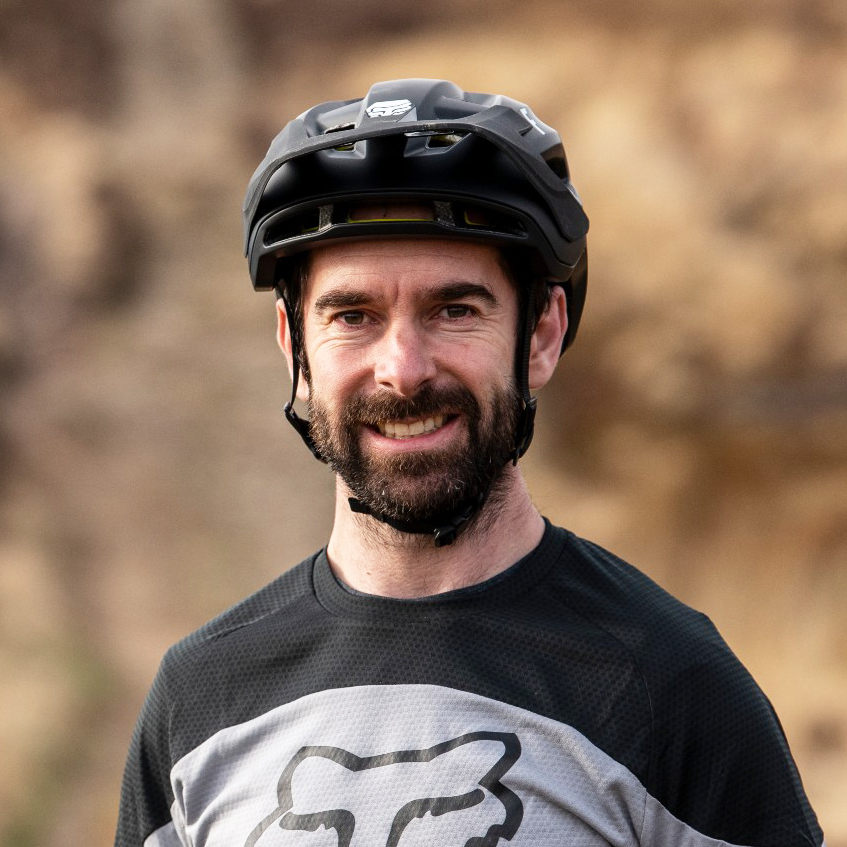Canyon has released a steering stabilisation system for the Spectral 29, providing self-centring steering and said to create a more stable ride on the trail.
The new K.I.S (Keep It Stable) system is the brainchild of Jo Klieber, the man behind parts brand Syntace and Liteville bikes. It's engineered by the team at Canyon.
This discreet system, which sits inside the top tube, provides a self-centring effect on the handlebars.
Canyon claims this adds control and stability to calm the handling when things are getting rough at high speeds, or when you’re tackling slow-paced technical sections of trail, improving, the brand says, the connection between your front and rear wheels.
Canyon will debut the new system on a modified version of its Spectral CF8 enduro bike, while Liteville will roll it out on its 301 CE electric mountain bike.
So, what is K.I.S, how does it work, and do we really need it? You can also jump to our first ride impressions on the Canyon Spectral 29 CF8 K.I.S.
Five things you need to know about the K.I.S steering stabilisation system
- K.I.S stands for Keep It Stable, and is a system designed to create a self-centring effect on your handlebars, which in turn is claimed to create a more stable ride on the trail
- At launch, K.I.S is only available on the Canyon Spectral 29 CF8 K.I.S and will soon be available on the Liteville 301 CE
- You can change the system’s strength with a 4mm Allen key
- Canyon and Syntace claim the K.I.S system requires no maintenance
- The complete K.I.S system weighs a claimed 110g
What is Canyon's Keep It Stable bicycle steering stabilisation system?

The K.I.S system is claimed to improve your connection with the front wheel, giving you a more accurate feel of what’s going on beneath your tyre by removing unwanted feedback from your handlebars.
It achieves this by automatically centring your bike’s handlebars and steering, straightening the front wheel to the twelve o'clock position.
The K.I.S system consists of a cam ring that’s bolted around the middle of the fork steerer. The cam is then connected to a coil spring that’s anchored within the top tube via an ultra-strong synthetic fibre band.

As you rotate the handlebar, one side of the band increases in tension and pulls the spring. The small force generated by the band and spring works to create a self-centring effect on the bar, trying to pull it back to its original, central position.
Jo Klieber, the man behind the technology, said over the course of nearly four years the K.I.S system went through 100 different iterations before the design team were happy with the result.
K.I.S adjustability
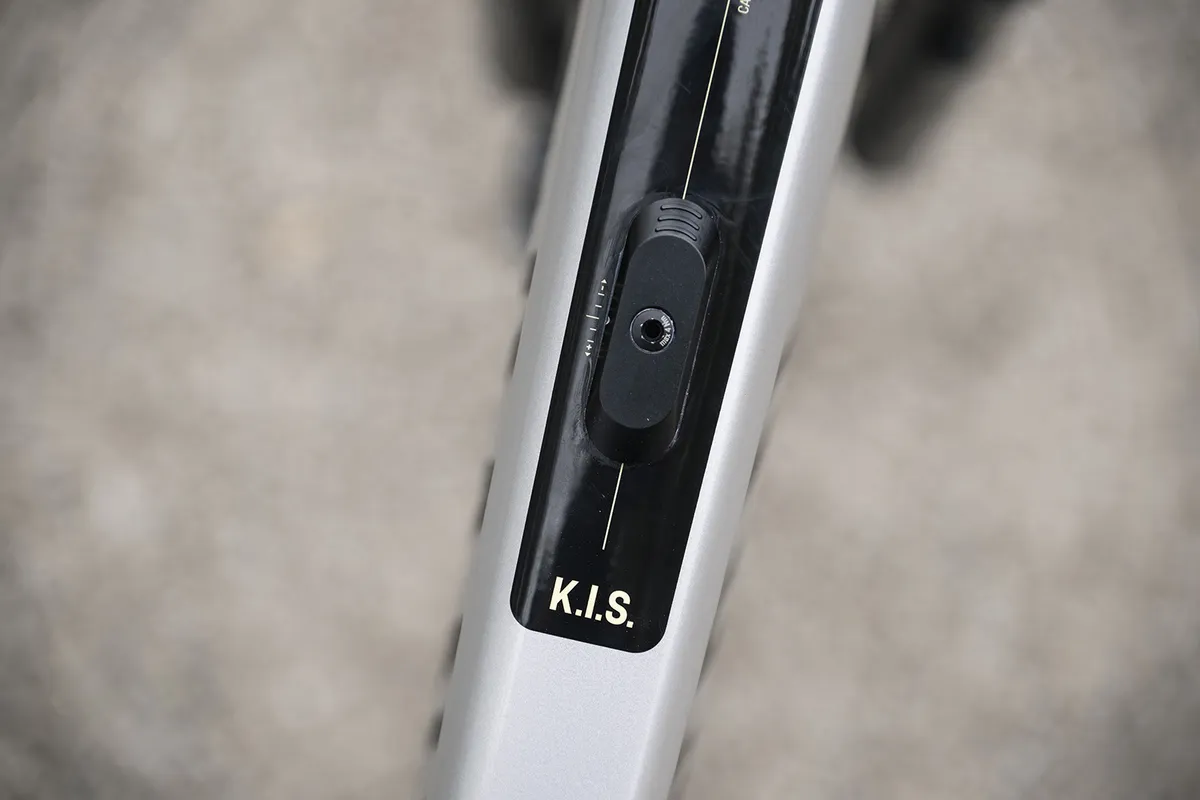
The slider that enables you to adjust the K.I.S stabilister is the only visible part of the system – everything else is housed inside the head tube.
To adjust the system, you loosen the 4mm Allen bolt off and slide it forward towards the head tube. This lowers the self-centring force.
Pull it back towards the seat tube and you increase spring tension, and thus how much of an effect the K.I.S system exerts through the bars.
There’s also a little window at the front of the head tube to enable access to the cam ring clamp bolt. Access to the cam ring is required if you ever need to reset/re-align the system, or remove the fork.
The total system weight is claimed to be just 110g, and it is fully integrated into the frame.
Claimed to last a lifetime

The K.I.S system is claimed to require no maintenance and last the lifetime of a bike.
It’s a bold claim, but one both Canyon and Syntace are happy to stand behind.
An integrated steering limiter prevents the bars from spinning past 90 degrees, though it can still happen in extreme circumstances.
If you do have a big crash and properly clobber your bars (and bike), the K.I.S system may need to be re-centred/reset.
In this circumstance, the system has been engineered to slip when a certain force is reached to avoid damaging it.

The hardware is made from corrosion-resistant materials, while the coil springs and synthetic-fibre bands are said to require no maintenance.
Despite needing to cut a hole into its carbon frame to fit the system, Canyon says the modified Spectral still meets its CAT4 EWS-race-ready strength test.
Canyon made a point of us checking all the bikes ahead of riding to ensure the K.I.S system had bars sitting centrally before we set off.
To do this, you lift the front wheel and ensure things are aligned, just as you would your stem.
Why do we need K.I.S?

The primary goal of the K.I.S system is to increase steering stability.
The self-centring effect should, in theory, help to calm the steering down.
You might be thinking, “is that really an issue?”.
As bikes have developed over the years, head angles have slackened, fork offsets have decreased (after first increasing), and wheel diameters increased. All of this has helped to calm down the handling of modern mountain bikes.
However, balancing all of these factors isn’t easy.

On the trail, while trucking along at speed through the rough stuff, modern bikes (especially those with super-slack head angles) will feel surefooted and composed.
However, at slower speeds with higher steering angles, you may well start to feel the destabilising effects of wheel flop, where, at times, the steering can begin feeling nervous and twitchy.
While it’s fair to say most current bikes do a fine job of balancing these traits, Klieber still felt there was room for improvement.
The K.I.S system is designed to help calm this sensation, essentially tethering the unstable front wheel/steering assembly to the more stable and heavier frame and rear wheel.
According to Klieber, connecting the two helps to give a more predictable feel through the tyre.
Canyon claims this means dealing with situations where the bike is understeering or oversteering should feel more intuitive and easier to control.
Reducing fatigue
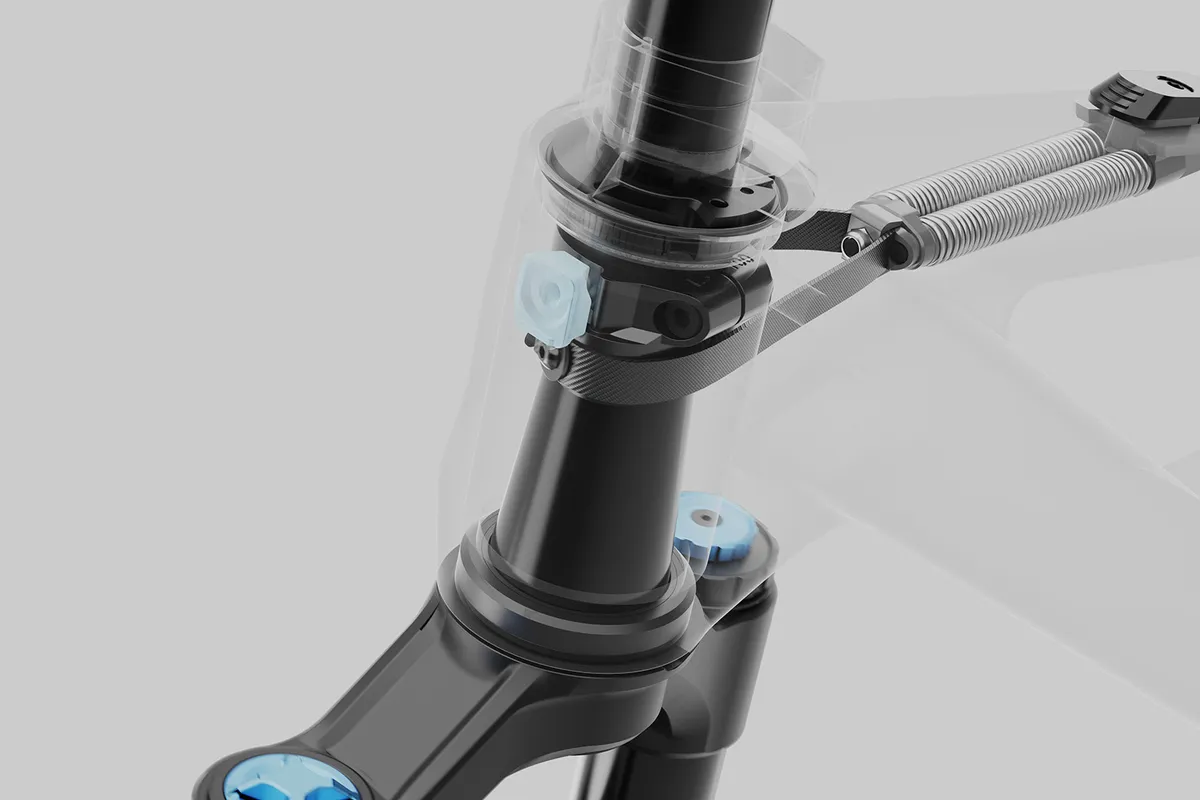
Klieber claims the system has other benefits beyond control.
According to Klieber, the calmer, more stable steering should help reduce fatigue.
When climbing at slow speeds on steep terrain, the front wheel is more inclined to wander. In these scenarios, we tend to give a burst of acceleration through the pedals in order to bring the front wheel back in line.
The K.I.S system should help to counter these situations by doing some of the work for us and helping the front wheel stay on the line intended.
Another good example is when drifting through a flat turn on loose gravel. In these situations, riders will regularly find themselves trying to counter steer and make small corrections through the bars. This can, at times, feel quite twitchy.

Again, in theory, that connection from front to rear should help calm this sensation, allowing you to counter steer with more control thanks to the calmer steering and improved connection from front to rear.
Canyon refers to this as a “weighted feeling to the steering that boosts your sense of stability”.
Canyon claims the small amount of force exerted on the bars by the K.I.S system is minimal, and the benefits outweigh any extra input required by the rider.
Canyon was keen to stress the K.I.S system does provide a very different feel through the handlebar, and will take time to adapt to.
How much time will vary from rider to rider, though some of the engineers from Canyon and Syntace said riding on it for a month will ensure you’re totally in tune with the change in handling.
Sounds like a steering damper, right?
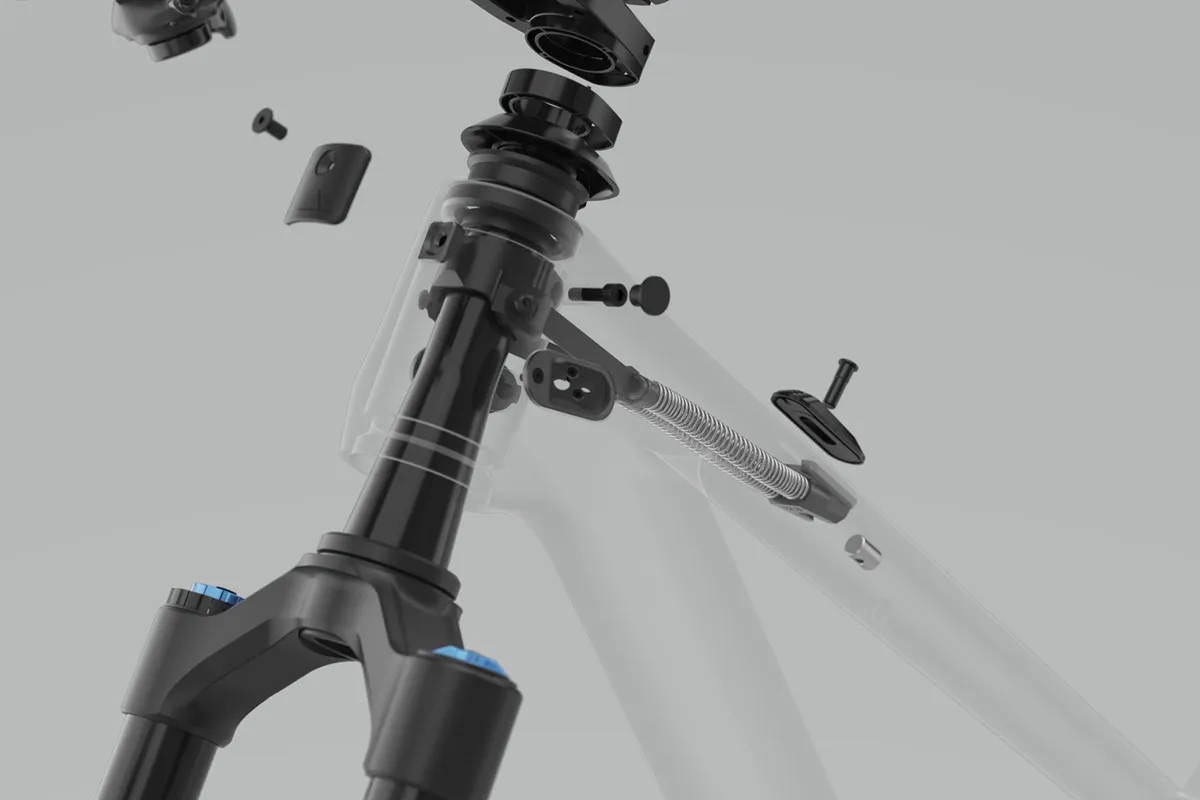
Klieber was keen to point out that, while there have been other systems and devices similar to K.I.S in the past, it isn’t a steering damper in the strictest sense of the word.
Many steering dampers add friction to stabilise or calm the steering, in many cases using a hydraulic damper to do this. The Cane Creek ViscoSet and Hopey steering damper are the best-known systems.
While these help to reduce ‘speed wobble’, some steering dampers negatively affect feel through the bar, with the added friction they create making for a bike that feels slow to react.
The K.I.S system doesn’t use a damper and, according to Klieber, shouldn’t feel restrictive or produce any kind of binding feel through the bars as you initiate a turn.
According to the Canyon team, the shaping of the cam ring means the torque curve (the rotational counter force that the system exerts on the steering as you turn the bars) produced as you rotate the handlebar should feel consistent no matter how far you turn them – “the system feels almost the same as you turn from 15 degrees to 50 degrees”.
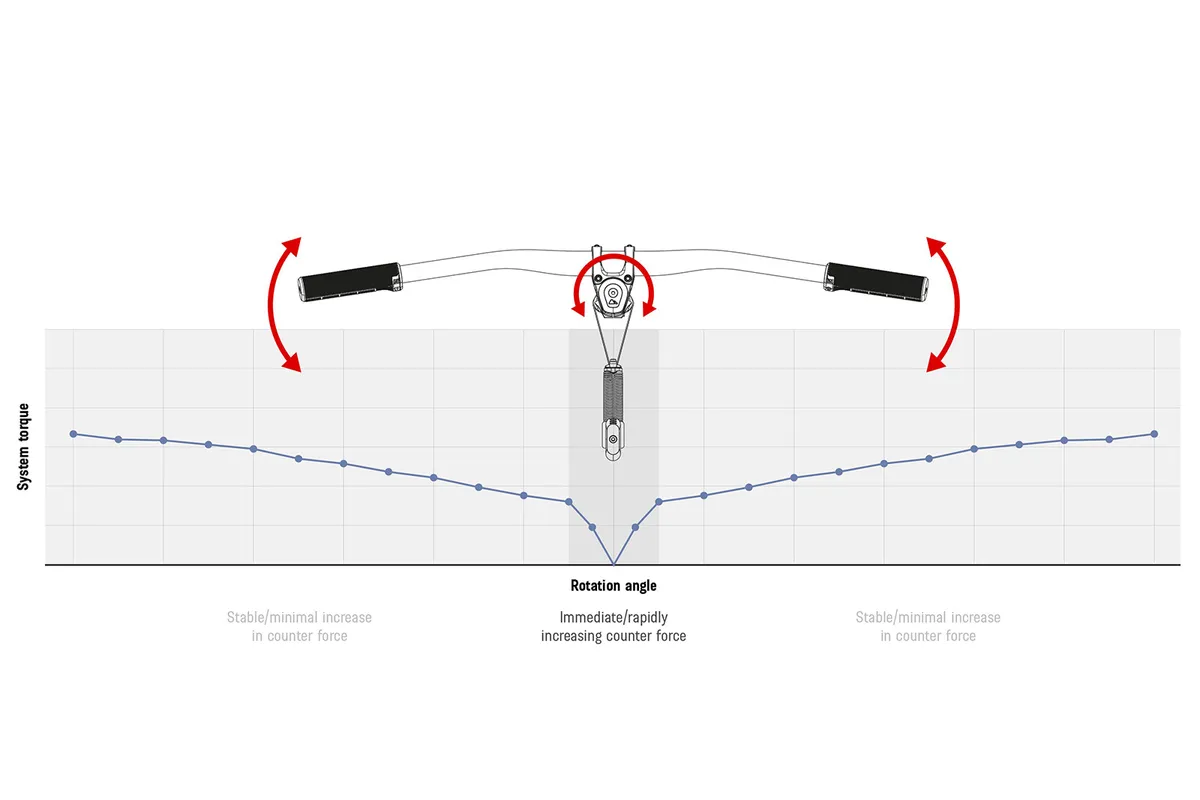
There is, however, a sharp ramp-up either side of the starting centre point (up to around 10 degrees). Canyon says the high initial centring force helps to keep the bike on line and stable.
This curve then flattens out significantly, which is what contributes to the consistent feel through the bars as you turn them.
Tuning the Canyon and Syntace K.I.S system

A key feature of the K.I.S system is its tunability.
While there are three clear settings, you can also clamp the slider in between these, opening up the scope to alter feel even further.
Canyon says a number of factors should be considered when setting up the system.
These include terrain and speed, as well as rider style, weight and size.
Slower trail speeds may require a lighter setting on the K.I.S system, while higher speeds in rougher terrain will likely benefit from a stronger setting.
Likewise, heavier or taller riders that produce more leverage on the bars will also more than likely be better off on a stronger setting. Smaller, lighter riders may well find the middle or lighter settings easier to get along with.
Which bikes will feature the K.I.S steering stability system?

At present, only two bikes will come with the K.I.S system. Canyon and Liteville have the exclusive rights over the system, but have said we can expect to see more bikes in their line-ups coming with K.I.S.
Th Canyon Spectral CF8 K.I.S commands a £400/€400 premium over the regular Spectral CF8, coming in at £4,999/€4,999. US pricing and further details on the Liteville 301 CE K.I.S are TBC.
Canyon Spectral 29 CF8 K.I.S

- Frame: Carbon, 150mm travel
- Fork: Fox 36 Performance Elite, 160mm travel
- Shock: Fox DPX2 Performance Elite
- Drivetrain: Shimano XT
- Brakes: Shimano XT
- Wheels: DT Swiss XM1700
- Price: £4,999/€4,999
Rob Weaver's Canyon Spectral 29 CF8 K.I.S initial ride impressions

I spent one day riding in the mountains just north of Nice, France, to get a feel for the new K.I.S.
The trails and bike were both unfamiliar to me, so these are very much initial impressions from my time on the bike.
I’m also focusing only on my experience with the K.I.S system, rather than the bike as a whole.

Assuming the bars and K.I.S are centred, and you’ve already selected the self-centring strength, there’s nothing that needs to be done regarding setup. I opted to start in the middle setting.
Riding uphill, it was only in certain low-speed scenarios – such as changing lines to find a smoother path or wiggling the bike up and out of a rut – that I could really notice the K.I.S system.
I didn’t feel as though I needed to work against the system as such – it just offers a different sensation through the bars, and one that I think could be quite easily forgotten over time.
Take your hands off the bars and you’ll soon feel the self-centring effect at work, though.

When descending at speed, I can’t say I noticed any negative effects.
The system is most noticeable when tackling flat, loose turns covered in gravel. Here, the bars simply felt less twitchy than I’d have expected. I could remain more neutral on the bike and never felt I was having to counter or fight excessive bar movements.
Switching into the stronger system setting was a little trickier than promised – pushing the slider into place before clamping it down took more effort than expected.
In the stronger setting, I certainly noticed the feel through the bars more when navigating slower hairpin-style turns, though I can’t say it felt as though I had to compensate or correct the steering when I did.

Riding one cambered section did feel a little odd, though. The sensation was similar to when your tyre catches the edge of a rut.
It’s hard to say whether this was down solely to K.I.S or the unfamiliar terrain, but it was something I was conscious of on a couple of occasions.
On the weakest setting, while still noticeable on the climbs, it was hard to feel any significant influence on the descents.

Overall, the short amount of time on the bike, riding on unfamiliar trails and the inability to properly test the system back-to-back means I can’t draw any firm conclusions just yet.
In certain scenarios, I certainly felt some benefits, but just as Klieber and the Canyon engineers said, it will take time to get accustomed to. We should have the Spectral 29 CF K.I.S here soon, so look out for a full review in due course.
